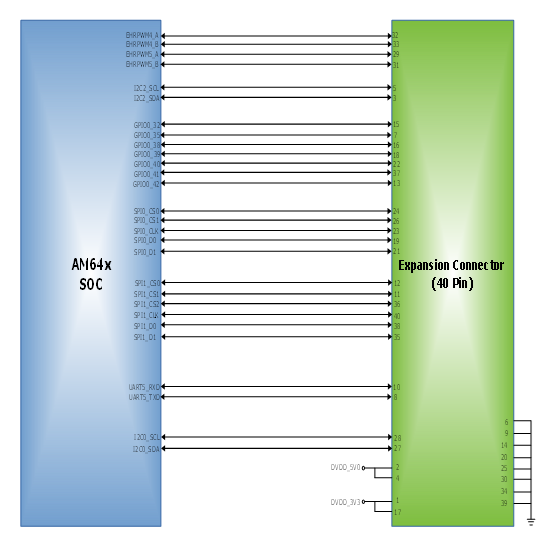SPRUJ64 September 2022
- Abstract
- Trademarks
- 1Key Features
- 2AM64x SKEVM Overview
- 3Functional Block Diagram
-
4System Description
- 4.1 Clocking
- 4.2 Reset
- 4.3 Power Requirements
- 4.4 Configuration
- 4.5 JTAG
- 4.6 Test Automation
- 4.7 UART Interface
- 4.8 Memory Interfaces
- 4.9 Ethernet Interface
- 4.10 USB 3.0 Interface
- 4.11 PRU Connector
- 4.12 User Expansion Connector
- 4.13 MCU Connector
- 4.14 Interrupt
- 4.15 I2C Interface
- 4.16 IO Expander (GPIOs)
- 5Known Issues and Modifications
- 6Revision History
4.12 User Expansion Connector
This connector is compatible with the standard expansion connector found on a Raspberry Pi®™ 4B, allowing seamless interface with HAT boards. Four mounting holes must be oriented with the connector to allow for connection of these boards. Signals connected from SoC to the Expansion Header include: SPI (0), SPI (1), UART (5), I2C (0), I2C (2), EHRPWM4_A / B, EHRPWM5_A / B along with GPIOs [32, 38, 39, 40, 41, 42] along with 5-V and 3.3-V PWR and GND. Each of the power supplies 5 V and 3.3 V are current limited to 155 mA and 500 mA, respectively. This is achieved by using load switch TPS22902YFPR. Enable for the load switch is controlled by the IO expander. Signals routed from User Expansion connector are listed in Table 4-21.
| Pin | Net Name | Pin | Net Name |
|---|---|---|---|
| 1 | VCC3V3_RPI | 2 | VCC5V0_RPI |
| 3 | RPI_I2C2_SDA | 4 | VCC5V0_RPI |
| 5 | RPI_I2C2_SCL | 6 | DGND |
| 7 | RPI_GPIO0_35 | 8 | SOC_MAIN_UART5_TXD |
| 9 | DGND | 10 | SOC_MAIN_UART5_RXD |
| 11 | RPI_SPI1_CS1 | 12 | RPI_SPI1_CS0 |
| 13 | RPI_GPIO0_42 | 14 | DGND |
| 15 | RPI_GPIO0_32 | 16 | RPI_GPIO0_38 |
| 17 | VCC3V3_RPI | 18 | RPI_GPIO0_39 |
| 19 | RPI_SPI0_D0 | 20 | DGND |
| 21 | RPI_SPI0_D1 | 22 | RPI_GPIO0_40 |
| 23 | RPI_SPI0_CLK | 24 | RPI_SPI0_CS0 |
| 25 | DGND | 26 | RPI_SPI0_CS1 |
| 27 | SoC_I2C0_SDA | 28 | SoC_I2C0_SCL |
| 29 | RPI_ETHRPWM5_A | 30 | DGND |
| 31 | RPI_ETHRPWM5_B | 32 | RPI_ETHRPWM4_A |
| 33 | RPI_ETHRPWM4_B | 34 | DGND |
| 35 | RPI_SPI1_D1 | 36 | RPI_SPI1_CS2 |
| 37 | RPI_GPIO0_41 | 38 | RPI_SPI1_D0 |
| 39 | RPI_HAT_DETECT | 40 | RPI_SPI1_CLK |
 Figure 4-19 40-Pin User Expansion
Connector
Figure 4-19 40-Pin User Expansion
Connector